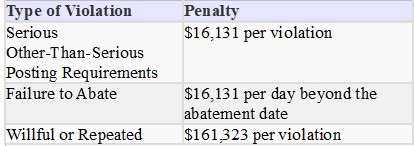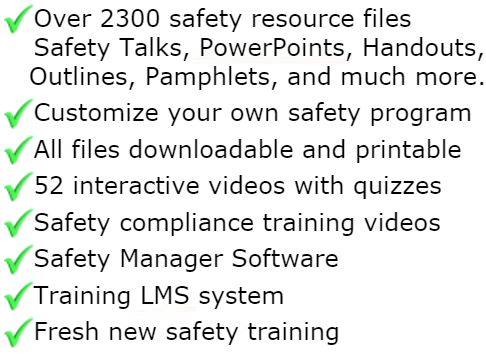
Hot Work Permits & Welding
Welding and Hot Work, such as brazing or grinding present a significant opportunity for fire and injury. All precautions of this program must be applied prior to commencing any welding or hot work by company employees or contractors. Hot work presents an increased risk of fire and explosion hazards because it is most often performed in confined and enclosed spaces. Reference: OSHA 29 CFR 1910.252
Hot Work Permits
Before hot work operations begin in a non-designated location, a completed hot work permit is required.
The following conditions must be confirmed before permitting the hot work to commence:
Equipment to be used (e.g. welding equipment, shields, personal protective equipment, fire extinguishers) must be in satisfactory operating condition and in good repair.
The floor must be swept clean for a radius of 35 ft if combustible materials, such as paper or wood shavings are on the floor,
Combustible floors (except wood on concrete) must be kept wet or be covered with damp sand ( note: where floors have been wet down, personnel operating arc welding or cutting equipment shall be protected from possible shock)., or be protected by noncombustible or fire-retardant shields.
All combustible materials must be moved at least 35 ft away from the hot work operation. If relocation is impractical, combustibles must be protected with fire-retardant covers, shields or curtains. Edges of covers at the floor must be tight to prevent sparks from going under them, including where several covers overlap when protecting a large pile.
OSHA has very specific regulations covering welding, brazing and cutting operations. Ventilation requirements depend on the metals and compounds used. Welding & cutting operations, conducted outside authorized hot work areas, includes extensive procedures for fire prevention.
Welding Hazards
• burns & fire
• impact
• penetration
• dust, smoke & fumes
• heat
• light radiation
• asphyxiation
Types of Welding & Cutting
Arc Welding is the process of using an electric current between a metal electrode and base metal. The generated heat melts the metal of the electrode and base metal which combine and then solidify in the weld joint.
Gas Welding process uses a gas flame to melt the edges of two adjoining surfaces. After removal of the flame, the liquid metal cools to join the surfaces together. Gases used with oxygen or air are acetylene, MAPP gas and hydrogen.
Cutting -- there are two common types of cutting done with welding equipment
• Oxygen cutting heats metal with a gas flame - an oxygen jet increases the heat and blows away the molten metal
• Arc cutting uses the high heat of an electric arc to melt a channel or hole in the metal.
Hot work is allowed only in areas that are or have been made fire-safe. Hot work may only be performed in either designated areas or permit-required areas.
A designated area is a specific area designed or approved for such work, such as a maintenance shop or a detached outside location that is of noncombustible or fire-resistive construction, essentially free of combustible and flammable contents, and suitably segregated from adjacent areas.
A permit-required area is an area made fire-safe by removing or protecting combustibles from ignition sources.
Hot work is not allowed:
• In sprinklered buildings if the fire protection system is impaired
• In the presence of explosive atmospheres or potentially explosive atmospheres ( e.g. on drums previously containing solvents)
• In explosive atmospheres that can develop in areas with an accumulation of combustible dusts (e.g. grain silos).
All materials in the members area for this topic index

GET INSTANT ACCESS
to THE MEMBERS LIBRARY
Safety materials created by safety professionals.
Access to the Safety Manager software.
Wide variety of safety videos and courses.
**Brand New** Safety Training Management System
Pre-Made Safety Materials Ready For Use
Created by experienced safety professionals & risk consultants. Saving you time, money, and risk of injuries.
95% of the work already done.
Below are the maximum penalty amounts, with the annual adjustment for inflation, that may be assessed after Jan. 15, 2024. (See OSHA Memo, Jan. 8, 2024).

**New OSHA HEAT 90 DAY**
>>Download Free HERE<<
**New 2024 OSHA 300 Form**
>>Download Free HERE<<
**Brand New**
Free with full membership subscription
Training LMS System
Ask The Safety Consultant
Safety Equipment Deal Finder

“SafetyInfo.com is the first go-to website for safety professionals and companies to use in establishing a solid safety program"
-Mike McKenzie, Certified Safety & Health Manager (CSHM), McSafety Solutions™
Note: You must have a full subscription to the Safety Library in order to use this material. Any use outside of your organization, for resell, or without an active membership is strictly prohibited and may result in prosecution under copyright infringement laws. Please contact us first, if you would be interested in reselling or using our materials for reproduction.
Inside the Members Library
Topic Index
Accident Prevention
Air Quality
Asbestos
Bloodborne Pathogens
Boilers
Chemical Safety
Compressed Gas
Confined Space
Construction
Construction Worksite
Cranes & Slings
Driver / Fleet Safety
Drug Free Workplace
Electrical
Emergency Management
Engineering Safety
Environmental
Equipment
Ergonomics
Fall Protection
Fire Safety & Prevention
First Aid
Flammable Materials
Forklifts
Hazard Communication
Hazardous Materials
Hearing Protection
Heat Stress
Hot Work
Housekeeping
Job Safety Analysis
Laboratory
Ladders
Lead
Lockout-Tagout
Machinery & Equipment
Material Handling
MSDS (SDS)
Medical & First Aid
Occupational Health
Office Safety
Off the Job Safety
Personal Protection
Process Safety
Record Keeping
Respiratory Protection
Silica Safety
Rules & Policies
Signs & Labels
Slips, Trips & Fall
Training
Terrorism Programs
Tool Safety
Vehicle & Driver
Violence Programs
Welding & Hot Work
Training Videos
Library Index
Training Materials
Videos/Courses
Talks
Articles
PowerPoint
Handouts
Training Overheads
Quizzes
Supervisor Briefs
Management Briefs
Safety Sessions
2 Minute OSHA Safety Talks
Pamphlets
First Aid Training
Supervisor Training
Hazardous Materials
Bomb Threat
Crossword Puzzles
Biological Agents
Forms & Documents
Forms
Checklists
Audit Guides
Inspections Guides
Signs & Labels
Environmental Audit Guides
Recordkeeping - OSHA 300
Sign & Label Maker
Safety Management Resources
Safety Manuals/Written Programs
Ergonomic Programs
Emergency Plans
Process Safety Management
Construction Safety
Occupational Health
Environmental
Topic Sheets
DOT Fleet-Driver
Hazardous Materials
Chemical Safety
Drug Free Workplace
Terrorism Programs
Development Guides
Safety Manager Software
Safety References & Graphics
Technical Safety Information
Posters
Topic & Fact Sheets
Development Information
Job Specific Safety Rules
Terrorism
Calculators
Safety Comic Strips
New Safety Training System
Schedule and train your employees with our materials. Add unlimited amount of employees. Record all progress and issue certificates. For group and individual training sessions.

